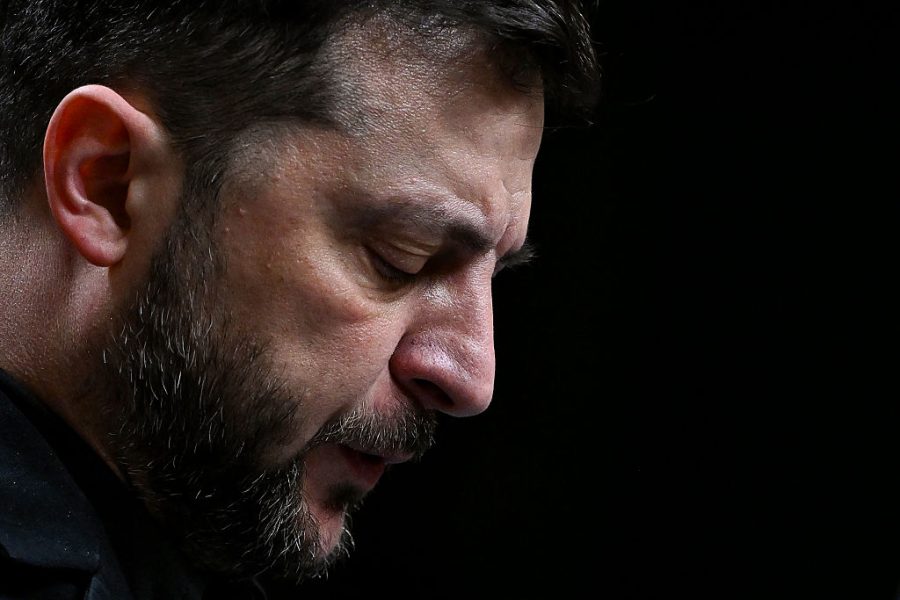You have to hand it to the curators of this excellent survey of Francis Bacon’s portraits. Not only have they alighted at an obvious but under-explored vantage point from which to reconsider this most mythologised of postwar painters, securing some serious loans to make their point, they have also dared to open their show with what might be the single worst picture it contains. ‘Self Portrait’ (1987) speaks of everything that Bacon got wrong in his final decades: it’s recognisably the 78-year-old artist, dressing up as a younger version of himself. His lips are pursed, his face pockmarked with a spray of tiny red dots, his pate capped with a page-boy fringe, features delivered in the borderline cartoonish idiom he seemed to lean on whenever a picture demanded something faithful to life.
If this show gets something right it is in refuting the hackneyed vision of Bacon-as-apocalyptic-magus
The artist’s powers were on the wane and he knew it. Self-parodic though the picture might be, it still carries the weight of pathos. Some years before, he had complained about being forced towards self-portraiture because his friends were ‘dropping like flies’. ‘I’ve nobody else left to paint but myself,’ he told David Sylvester. ‘I loathe my own face but I go on painting it only because I haven’t got any other people to do.’ He was exaggerating, but not by much. Of the recurring models pictured here, many were no longer: Muriel Belcher, the founder of the Colony Room, died in 1979; his abusive boyfriend Peter Lacy, captured here as some kind of demented jungle beast, in 1962; another lover, George Dyer – a Kray twins associate – the subject of this show’s big, climactic moment, ‘Triptych May-June 1973’, in 1971.
The work is Bacon’s delayed response to Dyer’s suicide in a Paris hotel room, when the pair were in France for the opening of the artist’s retrospective at the Grand Palais. ‘Trust George to fuck it up!’ Bacon had yelled on receiving the news – but the painting is as bleak as any in the canon. Across its three panels, Dyer is variously glimpsed shitting himself dry, vomiting blood and staring into we-know-not-what. Any veneer of civilisation has been stripped away from this wretched figure, recognisable as human from his distinctive aquiline profile alone.
Dyer’s silhouette haunts proceedings. We variously see him in half-melted outline riding a bike; moulded to a mangled, clownish version of himself, gazing into a rectangular mirror; and as an ageing mod in three-buttoned jacket, his legs spilling out onto a flight of stairs in 1972’s ‘Portrait of Man Walking Down Steps’.
We tend not to think of Bacon as a portraitist. His exercises in the genre are understood as extensions of his alarming wider aesthetic. He certainly wasn’t a traditional portraitist. He never painted to order, only once accepting a commission: the result, a 1955 portrait of his patron Robert Sainsbury, is a borderline risible attempt to force a convincing likeness on to the artist’s favoured style of the time when he had taken to painting anonymous businessmen emerging from spectral darkness.
He obviously liked the supermarket magnate, and the fondness didn’t make for a harmonious composition. With his sheepish expression, Sainsbury has the air of a beloved elder statesman rumbled after accidentally walking into a brothel. Rather better is Bacon’s portrayal of Lisa Sainsbury, her features imprisoned behind shuttered, vertical brushstrokes that lend the image a weirdly votive quality.
Bacon never went in for Warhol-style celebrity portraiture. Instead he favoured returning to a tight circle of friends. From the 1960s, however, he did base these portraits – like Warhol – almost exclusively on photographs. The regulars are all present, at times giving the show the feel of a Thursday night on Dean Street. Lucian Freud appears from various angles in a spooky 1964 triptych (a format Bacon likened to police ID shots), and in a thrilling double portrait with Frank Auerbach, the two painters lounging on comfy chairs in white T-shirts and jeans. Henrietta Moraes is here, too, her profile distinct despite being mangled across another triptych. And there’s Isabel Rawsthorne, distorted to the point at which she begins to resemble a fur-clad toad. The elements don’t entirely come together in many, if not most of these paintings: flourishes aspiring to drama frequently fall far short of the desired effect, sometimes almost risibly so. Yet such weaknesses only serve to throw the passages of originality and bravado into focus. Bacon may never have made a genuinely faultless portrait, but his flaws are instructive.
If this exhibition really gets something right, it is in refuting the hackneyed vision of Bacon-as-apocalyptic-magus. Captions are clear, informative and unsensational, leading you to conclude that everything we hear about him as the great painter of the post-Holocaust era was in fact a misreading of the artist’s theatricality and intense scrutiny of Christian imagery. There’s darkness in his work, to be sure – one self-portrait derives from images of mutilated bomb victims – but it’s always offset by a healthy appreciation of the absurd and a touching dose of sadness. For all his talk of man-as-meat, Bacon was a deeply humanistic painter.







Comments